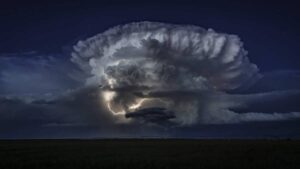Drilling uncovers evidence of regional-scale copper system at American West’s Storm Project

Copper elephants might not be restricted to Africa if American West’s deep diamond drilling results are anything to go by. Pic via Getty Images.
Excitement is brewing at American West’s Storm Project in Canada after drilling intersected thick intervals of copper sulphides with similarities to many major sediment-hosted copper systems.
Notably, the intersects from drilling at the Project on Somerset Island, Nunavut, draw comparison to the rich deposits of the Kalahari and Central African copper belts that typically have metre scale thicknesses and kilometre scale strikes of the ore zones.
This incidentally also proves American West Metals’ (ASX:AW1) belief that Storm’s distinct zonation of metal and mineralogy that appears as a large copper-rich core which gives way laterally and vertically to thinner peripheral zones of copper-iron, iron, zinc, and minor lead, are key features similar to the African deposits.
Whilst assays are still pending, that holes ST23-01 and ST23-02, which are 680m apart, have intersected 45.5m and 37m of visible mineralisation respectively is certainly encouraging both for its potential copper content and extent of mineralisation.
The latter is particularly intriguing as the continuity of the mineralised horizon and the size of the gravity anomaly – more than 5km long and up to 1km wide – suggests that a very large copper deposit has been uncovered by the drilling.
Additionally, the intersection of mineralisation at the top of modelled gravity anomaly in both holes validates the company’s exploration targeting technique.
This is hugely positive as it greatly improves the prospectivity of untested gravity targets which cover an extensive area at Storm and are similar to those intersected by the initial diamond holes, supporting the potential for a major, regional-scale copper system to be present within the project.
Massive potential
“We are very excited to announce that the diamond drilling has had immediate success and produced spectacular results confirming the presence of a major copper system within the Storm project,” Managing Director Dave O’Neill said.
“These outstanding results are the product of systematic and persistent exploration, and further highlight the quality and huge exploration potential of the landholding.
“The first two drill holes have discovered a new copper deposit below the near-surface mineralisation with both holes intersecting thick intervals of copper sulphide at the same stratigraphic horizon.”
He added that the intersected thick, sulphide and organic-rich unit is believed to be the source of the gravity anomalism and that between the drilled target been the first in a series of extensive gravity anomalies defined earlier this year as well as the large spacing between drill holes and size of the modelled gravity anomalies, these were signs of potentially large volumes of mineralisation.
“The scale of the opportunity is enormous, with airborne and ground gravity anomalies that extend for over 10km to the east into our Blizzard and Tornado Prospect areas.”
Visible mineralisation
Hole ST23-01 had intersected 45.5m of visual sulphides comprising 30.5m of breccia-style visual copper sulphide (mostly chalcocite) within three zones associated with the shallow copper mineralisation of the 4100N Zone from a down-hole depth of 45m and 15m of visual breccia and vein-style copper sulphide (mostly chalcopyrite) from 332m.
Meanwhile, ST23-02 intersected what the company described as a more impressive 37m zone of visual breccia-style copper sulphide (dominantly chalcocite) from 333m.
The visual breccia zones are interpreted to be the same mineralised stratigraphic horizon that is hosted within a vuggy, organic-rich sequence that has a higher density than the surrounding stratigraphy and is interpreted to be the source of the gravity anomalism.
Importantly for the company, this is the first intersection of the high-copper content mineral chalcocite – a high-value copper ore mineral which is typical in sediment hosted copper deposits – at this stratigraphic interval.
Chalcocite is typical in sediment hosted copper deposits, including the deposits of the Kalahari Copper Belt and Central African Copper Belt, and is an important and high-value copper ore mineral.
The stratigraphic horizon is also interpreted to correlate with the stronger copper mineralisation intersected in 2022 drill hole ST22-10 about 50m to the south.
Forward program
Diamond drilling to test key geophysical and geological copper targets at Storm is continuing with a third hole underway about 1.7km south of ST23-02, and 1km west of the high-grade 2750N Zone.
This hole is testing a large gravity anomaly and EM conductor in an area with limited previous drilling.
Initial assays from the diamond drilling are expected in the next four weeks.
American West is also continuing reverse circulation resource definition drilling at the 2750N and 2200N Zones.
Drilling will also focus on expansion of the 4100N Zone and test several new, near-surface copper targets.
First assays are expected in the first two to three weeks.
Other work includes the continuation of the ore sorting, beneficiation and process optimisation on a range of ore types as well as the start of environmental baseline survey in mid-August 2023.
This article was developed in collaboration with American West Metals, a Stockhead advertiser at the time of publishing.
This article does not constitute financial product advice. You should consider obtaining independent advice before making any financial decisions.
Related Topics

UNLOCK INSIGHTS
Discover the untold stories of emerging ASX stocks.
Daily news and expert analysis, it's free to subscribe.
By proceeding, you confirm you understand that we handle personal information in accordance with our Privacy Policy.








